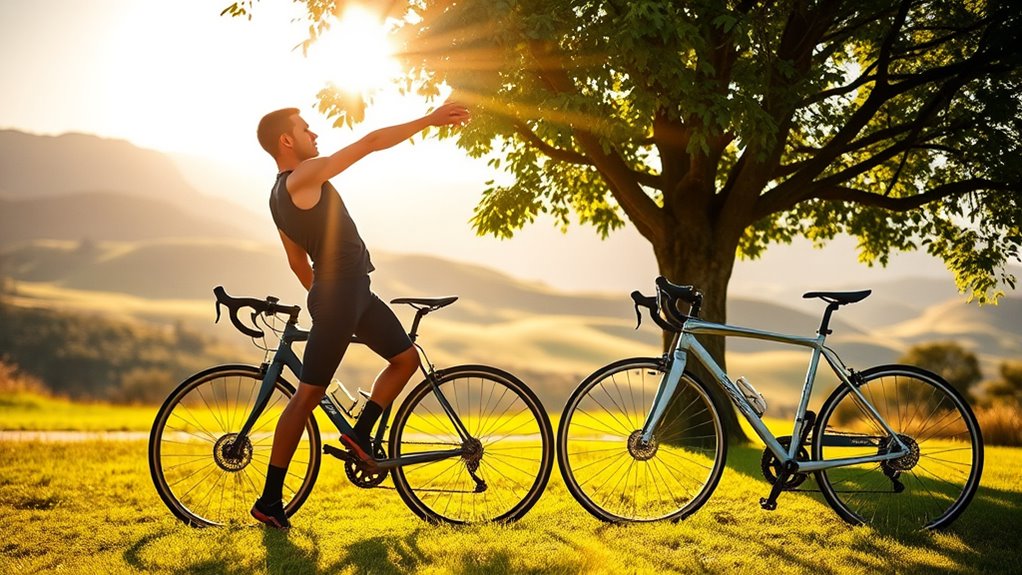Stretching is essential for cyclists since it boosts your performance and helps prevent injuries. A dynamic pre-ride routine prepares your muscles for the effort ahead, while a targeted post-ride routine enhances recovery and maintains flexibility. Incorporate key stretches like the Cat Camel and Downward Dog to improve your range of motion and re-engage muscles after a ride. By integrating these routines, you can maximize your cycling benefits and enjoy a more comfortable experience on the bike. There’s even more to explore!
Key Takeaways
- Stretching enhances flexibility and range of motion, improving overall cycling performance and efficiency.
- Dynamic stretches before rides, like the Cat Camel and Bird Dog, help prevent injuries and prepare muscles for exertion.
- Post-ride static stretching, such as Downward Dog and Glute Stretch, aids recovery and maintains long-term muscle flexibility.
- Engaging in targeted stretches promotes muscle balance, reducing tightness and the risk of injuries for both experienced and novice cyclists.
- Controlled breathing during post-ride stretches enhances relaxation and maximizes recovery benefits, ensuring better performance in future rides.
Importance of Stretching for Cyclists

Stretching is essential for cyclists because it greatly boosts your flexibility and range of motion, which are key for both performance and comfort during your rides.
Regular stretching, especially in areas like the hip flexors and lower back, helps prevent injuries by maintaining muscle balance and reducing tightness. Incorporating dynamic stretching before your ride prepares your muscles for the exertion ahead, while static stretching afterward aids recovery and preserves long-term flexibility.
Studies show that consistent stretching can improve vascular function and reduce arterial stiffness, offering health benefits beyond cycling performance. Additionally, a growth mindset can further enhance your cycling performance by encouraging you to embrace challenges and learn from experiences.
Pre-Ride Stretching Routine

Before you hit the road, incorporating a set of dynamic stretches can greatly enhance your performance and minimize the risk of injury. A pre-ride warm-up is essential for preparing your muscles for activity.
Stretching before a ride, consider including the Cat Camel, Bird Dog, and World’s Greatest Stretch. These dynamic stretches target vital muscle groups, promoting better muscle engagement. Remember to time your stretches with exhalations to increase relaxation and effectiveness.
Additionally, incorporating unilateral movements helps balance muscle engagement, which is important for maintaining proper cycling form. This routine not only readies experienced cyclists but also serves as a valuable cross-training session for those new to the sport, ensuring you’re fully prepared for the ride ahead. Furthermore, just as color accuracy is crucial in home cinema projectors for enhancing visual experiences, proper stretching can significantly improve your overall cycling performance and comfort.
Key Pre-Ride Stretches

To maximize your cycling performance and reduce the risk of injury, incorporating key pre-ride stretches into your routine is essential.
Start with dynamic movements like the Cat Camel to improve upper back and shoulder range of motion while engaging core stability.
The Bird Dog enhances limb mobility and torso stability, making it a perfect addition.
Don’t forget the World’s Greatest Stretch, which targets hip flexors and upper body flexibility.
Leg Swings dynamically engage hip flexors, promoting strength and flexibility.
Windmills also encourage hip and lower back flexibility while engaging core muscles.
Incorporating unilateral movements helps address potential asymmetries, ensuring balanced muscle engagement.
Always time your stretches with controlled breathing to enhance relaxation and effectiveness, setting you up for a great ride. Additionally, maintaining hydration before and during your ride can significantly improve your overall performance and recovery.
Post-Ride Stretching Routine

After you finish your ride, incorporating a post-ride stretching routine can greatly enhance your recovery.
Start with 4-5 deep breaths to center yourself, gradually increasing to 10 while focusing on controlled breathing. This relaxation technique helps improve flexibility and rebalances your muscular system after cycling.
Engage in key stretches like the Downward Dog, which effectively stretches your hamstrings and upper back, and the Deep Squat with Overhead Reach, targeting your upper back and glutes.
Holding each stretch for about 45 seconds maximizes benefits, promoting efficient recovery and reducing muscle stiffness. Additionally, consider integrating advanced sensors to enhance your overall wellness routine, as they can help track your physical activities and recovery progress.
Key Post-Ride Stretches

While cycling can be invigorating, it often leads to muscle tightness and imbalances that post-ride stretches can help alleviate. Incorporating key stretches into your routine is essential for enhancing recovery and flexibility.
- Downward Dog: This stretch targets the hamstrings, calf muscles, upper back, and shoulders, improving overall flexibility.
- Deep Squat with Overhead Reach: Focuses on the upper back, posterior chain, and inner thighs, promoting better mobility.
- Reverse Lunge: Effectively stretches the posterior hip area, improving front ankle mobility.
Don’t forget the Glute Stretch—it’s perfect for relaxing while practicing controlled breathing to maximize recovery benefits. Additionally, incorporating mindfulness practices into your post-ride routine can further enhance your overall recovery experience.
Hold each stretch for about 45 seconds to truly reap the rewards.
Frequently Asked Questions
Why Is Stretching Important for Cyclists?
Stretching’s essential for you as a cyclist because it enhances your flexibility and range of motion.
By incorporating regular stretching into your routine, you can prevent injuries and reduce tightness in key areas like your hip flexors and lower back.
Stretching also prepares your muscles for activity, helping you ride more comfortably.
Plus, it promotes relaxation and counters muscle imbalances caused by repetitive cycling movements, improving your overall performance and enjoyment on the bike.
Is It Better to Stretch Before or After Cycling?
Think of your muscles as a finely tuned instrument; they need the right warming up before a performance.
So, stretching before cycling helps prepare you for the ride ahead, enhancing flexibility and power.
However, after you’ve pedaled hard, static stretching becomes your best friend, easing tightness and promoting recovery.
It’s not about choosing one over the other; it’s about harmonizing both to elevate your cycling experience and keep your body in peak condition.
What Is the Importance of Stretching Before and After Workouts?
Stretching before and after workouts is essential for your performance and recovery.
Before exercising, it warms up your muscles, enhances flexibility, and reduces injury risks.
After your workout, stretching helps to alleviate muscle tightness, promotes relaxation, and accelerates recovery, keeping soreness at bay.
What Is Pre Stretching and Post Stretching?
Pre-stretching, or dynamic stretching, involves movements that warm up your muscles and boost blood flow, preparing you for physical activity.
It’s great for enhancing your range of motion.
Post-stretching, or static stretching, occurs after your workout and focuses on lengthening your muscles to aid recovery and flexibility.
This helps reduce tightness and soreness, ensuring you feel better after your sessions.
Both types are essential for peak performance and injury prevention.
Conclusion
Incorporating stretching into your cycling routine is like oiling the gears of your bike—essential for smooth performance. By taking just a few minutes to stretch before and after your rides, you’ll not only enhance your flexibility but also reduce the risk of injuries. As you pedal through miles of road, remember that your muscles deserve some love too. Embrace these routines, and you’ll find yourself riding stronger and recovering faster, ready for the next adventure ahead.
















